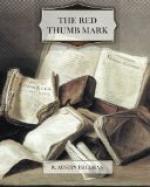He took from his assistant’s hand a photograph ten inches long by eight broad, done on glazed bromide paper and mounted flatly on stiff card. It showed a greatly magnified facsimile of one of the thumb-prints, in which all the minute details, such as the orifices of the sweat glands and trifling irregularities in the ridges, which, in the original, could be seen only with the aid of a lens, were plainly visible to the naked eye. Moreover, the entire print was covered by a network of fine black lines, by which it was divided into a multitude of small squares, each square being distinguished by a number.
“Excellent, Polton,” said Thorndyke approvingly; “a most admirable enlargement. You see, Jervis, we have photographed the thumb-print in contact with a numbered micrometer divided into square twelfths of an inch. The magnification is eight diameters, so that the squares are here each two-thirds of an inch in diameter. I have a number of these micrometers of different scales, and I find them invaluable in examining cheques, doubtful signatures and such like. I see you have packed up the camera and the microscope, Polton; have you put in the micrometer?”
“Yes, sir,” replied Polton, “and the six-inch objective and the low-power eye-piece. Everything is in the case; and I have put ’special rapid’ plates into the dark-slides in case the light should be bad.”
“Then we will go forth and beard the Scotland Yard lions in their den,” said Thorndyke, putting on his hat and gloves.
“But surely,” said I, “you are not going to drag that great microscope to Scotland Yard, when you only want eight diameters. Haven’t you a dissecting microscope or some other portable instrument?”
“We have a most delightful instrument of the dissecting type, of Polton’s own make—he shall show it to you. But I may have need of a more powerful instrument—and here let me give you a word of warning: whatever you may see me do, make no comments before the officials. We are seeking information, not giving it, you understand.”
At this moment the little brass knocker on the inner door—the outer oak being open—uttered a timid and apologetic rat-tat.
“Who the deuce can that be?” muttered Thorndyke, replacing the microscope on the table. He strode across to the door and opened it somewhat brusquely, but immediately whisked his hat off, and I then perceived a lady standing on the threshold.
“Dr. Thorndyke?” she inquired, and as my colleague bowed, she continued, “I ought to have written to ask for an appointment but the matter is rather urgent—it concerns Mr. Reuben Hornby and I only learned from him this morning that he had consulted you.”
“Pray come in,” said Thorndyke. “Dr. Jervis and I were just setting out for Scotland Yard on this very business. Let me present you to my colleague, who is working up the case with me.”
Our visitor, a tall handsome girl of twenty or thereabouts, returned my bow and remarked with perfect self-possession, “My name is Gibson—Miss Juliet Gibson. My business is of a very simple character and need not detain you many minutes.”




